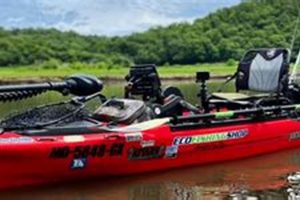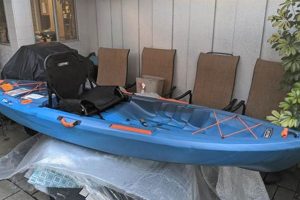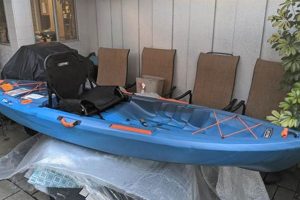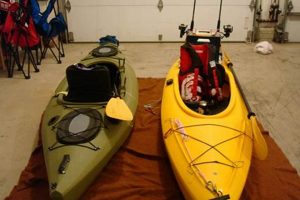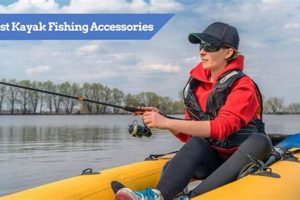Creating custom gear for kayak angling offers anglers an opportunity to personalize their fishing experience and potentially save money. Examples include rod holders fashioned from PVC pipe, tackle storage solutions built from repurposed containers, and even anchor systems crafted from readily available materials. These modifications cater to individual needs and preferences, enhancing both comfort and functionality on the water.
Customizing fishing kayaks with self-made equipment allows anglers to address specific challenges posed by their fishing environment or target species. It fosters a sense of self-reliance and ingenuity, allowing for experimentation and adaptation. Historically, anglers have often adapted tools and techniques based on available resources. This spirit of innovation continues in the modern practice of creating personalized kayak fishing setups.
This exploration will delve further into specific categories of customizable kayak fishing equipment, offering practical guidance and inspiration for anglers seeking to enhance their on-the-water experience. Topics covered will include rod storage and organization, tackle management systems, anchoring solutions, and other creative adaptations for kayak angling.
Tips for Creating Effective Kayak Fishing Accessories
Careful planning and execution are crucial for crafting functional and durable fishing accessories. The following tips offer guidance for maximizing effectiveness and ensuring a safe, enjoyable angling experience.
Tip 1: Prioritize Stability: Any additions should not compromise the kayak’s balance. Low-profile designs and even weight distribution are critical, especially in challenging conditions. Consider the impact on the kayak’s center of gravity.
Tip 2: Select Durable Materials: Marine-grade components withstand exposure to water, sunlight, and stress. Opt for rust-resistant metals, UV-resistant plastics, and robust fastening hardware. This ensures longevity and reliable performance.
Tip 3: Measure Twice, Cut Once: Precise measurements and careful cutting are essential for proper fit and function. Test-fitting components before final assembly helps prevent errors and material waste. Accurate planning is paramount.
Tip 4: Secure All Attachments: Ensure all additions are securely fastened to the kayak using appropriate hardware. Reinforce high-stress areas to prevent failure under pressure. Thoroughly inspect attachments regularly for signs of wear or loosening.
Tip 5: Consider Accessibility: Position accessories for easy reach and efficient use while on the water. Avoid obstructing paddling strokes or creating entanglement hazards. Optimize placement for seamless integration with fishing techniques.
Tip 6: Test and Refine: Thorough on-water testing reveals potential issues and areas for improvement. Evaluate performance under realistic fishing conditions and make adjustments as needed. Iterative refinement leads to optimal functionality.
Tip 7: Research Regulations: Familiarize oneself with local regulations regarding kayak modifications and fishing practices. Ensure all additions comply with safety and environmental guidelines. Responsible angling practices are paramount.
By adhering to these guidelines, anglers can create effective and safe custom kayak fishing accessories. This enhances both the enjoyment and productivity of time spent on the water.
These practical tips provide a foundation for creating a customized kayak fishing setup. Further sections will explore specific accessory projects and offer detailed construction guidance.
1. Customization
Customization lies at the heart of DIY kayak fishing accessories. It empowers anglers to address specific needs and preferences unmet by commercially available products. This direct link between angler ingenuity and resulting gear creates setups uniquely suited to individual fishing styles, target species, and waterway characteristics. For example, a bass angler fishing in heavily vegetated areas might craft a custom weed guard for their trolling motor, while a fly fisherman might devise a specialized fly storage system integrated into their kayak’s gunwale. These personalized adaptations improve efficiency and overall fishing success. Cause and effect are clearly demonstrated: the desire for specialized function leads to the creation of a custom solution.
The importance of customization as a component of DIY kayak fishing accessories extends beyond mere personalization. It fosters innovation and encourages anglers to experiment with different designs and materials. This process often leads to the discovery of novel solutions that improve upon existing commercial products or address previously unsolved challenges. A common example is seen in custom rod holder designs, where anglers often incorporate unique features like adjustable angles, integrated lighting, or specialized mounts for specific rod types. This continuous refinement driven by individual needs pushes the boundaries of kayak fishing gear design.
Understanding the significance of customization in DIY kayak fishing highlights the inherent resourcefulness within the angling community. It showcases the capacity to adapt and improve equipment based on practical experience and a deep understanding of the sport’s demands. While challenges such as material sourcing and fabrication techniques may arise, the resulting personalized setup offers a level of functionality and satisfaction often unattainable through commercially produced gear alone. This drive for customized performance remains a defining characteristic of DIY kayak fishing accessories.
2. Cost-effectiveness
Cost-effectiveness represents a significant motivator for creating do-it-yourself kayak fishing accessories. Commercial fishing gear, especially specialized equipment for kayaks, often carries a premium price. Building accessories allows anglers to bypass these costs, allocating resources towards other essential gear or experiences. This practice becomes particularly attractive when outfitting a kayak with multiple specialized accessories.
- Repurposing Materials
Repurposing existing materials drastically reduces expenses. Common household items, such as PVC pipe for rod holders or milk crates for storage, can be adapted for kayak fishing at minimal cost. This resourceful approach minimizes waste and reduces the financial burden associated with outfitting a kayak. For instance, using readily available bungee cords and carabiners to create a paddle leash offers a cost-effective alternative to purchasing a specialized product.
- Targeted Functionality
DIY accessories permit anglers to build precisely what they need, avoiding extraneous features often included in commercial products. This targeted approach avoids paying for unnecessary additions, maximizing value for money. Building a custom-sized tackle box designed to hold specific lures and tools, for example, eliminates the cost of compartments or features that remain unused.
- Long-Term Savings
While the initial investment of time and effort is a factor, DIY accessories can offer substantial long-term savings. Durable construction and the ability to repair or modify self-made gear reduces the need for frequent replacements. This long-term perspective highlights the financial benefits of DIY, especially for frequently used equipment like anchor trolleys or rod holders.
- Balancing Cost and Quality
Cost-effectiveness in DIY doesn’t necessarily imply compromising quality. Careful material selection and meticulous construction can yield durable and high-performing accessories. Opting for marine-grade hardware and weather-resistant materials ensures longevity and reliable performance, often rivaling or exceeding the quality of commercial alternatives. Building a sturdy, weatherproof electronics mount using readily available components, for instance, provides comparable functionality to expensive commercial mounts while reducing cost significantly.
Ultimately, the cost-effectiveness of DIY kayak fishing accessories empowers anglers to maximize their resources and personalize their on-the-water experience without significant financial strain. It represents a practical and often rewarding approach to equipping a kayak for optimal fishing performance.
3. Functionality
Functionality serves as the driving force behind the design and creation of DIY kayak fishing accessories. Effective accessories directly enhance on-the-water performance, improving efficiency, comfort, and overall fishing success. Form follows function; each element must serve a practical purpose contributing to a more streamlined and productive angling experience. This principle guides the creation of effective, purpose-built gear.
- Ergonomics and Accessibility
Ergonomics play a crucial role in functional design. Accessories should be positioned for easy access and comfortable use, minimizing awkward reaches or movements that disrupt fishing flow. A well-placed rod holder, for example, allows for quick access and effortless retrieval, while a strategically positioned fish finder display maximizes visibility without hindering paddling or casting. Prioritizing ergonomic principles ensures seamless integration of accessories into the angling process.
- Space Optimization and Storage
Kayaks offer limited space, making efficient storage essential. DIY accessories offer customized storage solutions tailored to specific gear and kayak layouts. Custom tackle boxes designed to fit within available compartments, or rod holders that minimize deck clutter, exemplify this principle. Maximizing storage capacity allows anglers to carry essential equipment without compromising stability or maneuverability.
- Streamlining Fishing Techniques
Specialized accessories streamline specific fishing techniques. A custom-built anchor trolley system facilitates controlled drift fishing, while a strategically placed camera mount captures underwater footage for analysis and documentation. These targeted adaptations enhance specific aspects of the angling process, contributing to improved results and a more refined approach. DIY solutions allow anglers to address niche requirements not always met by commercial products.
- Adaptability and Versatility
Functional design considers adaptability to changing conditions or fishing styles. Adjustable rod holders that accommodate different rod lengths or removable storage compartments that allow for reconfiguration exemplify this versatility. This adaptability expands the utility of DIY accessories, catering to diverse fishing scenarios and evolving angler preferences. Modular designs and adjustable components contribute significantly to long-term functionality.
The emphasis on functionality in DIY kayak fishing accessories underscores the practical nature of the pursuit. By prioritizing performance-enhancing features and addressing specific needs, anglers create personalized setups that maximize efficiency and enjoyment on the water. These custom solutions, driven by functionality, often provide a competitive edge and enhance the overall kayak fishing experience. The ultimate measure of success lies in how effectively these accessories contribute to a more productive and enjoyable fishing trip.
4. Material Selection
Material selection significantly influences the performance, durability, and longevity of DIY kayak fishing accessories. Choosing appropriate materials requires careful consideration of environmental factors, intended use, and desired functionality. Compromising on material quality can lead to equipment failure, potentially jeopardizing safety and fishing success. The following facets highlight key considerations in material selection for kayak fishing applications.
- Durability and Weather Resistance
Durability is paramount for equipment exposed to harsh marine environments. Materials must withstand prolonged exposure to sunlight, saltwater, and fluctuating temperatures. UV-resistant plastics, marine-grade aluminum, and stainless steel offer excellent durability and corrosion resistance. Choosing inferior materials can lead to premature degradation, requiring frequent replacements and potentially compromising safety on the water. For example, using untreated wood for a rod holder will quickly deteriorate, while marine-grade plywood offers lasting performance.
- Weight and Buoyancy
Weight considerations are crucial for maintaining kayak stability and maneuverability. Adding excessive weight can negatively impact performance and increase the risk of capsizing. Lightweight yet strong materials, such as high-density polyethylene (HDPE) plastics and aluminum alloys, are preferred choices. Buoyancy also factors into material selection, especially for accessories that may become submerged. Closed-cell foam and buoyant plastics prevent added weight should the accessory fall overboard. For instance, a heavy metal anchor trolley system can destabilize a kayak, whereas a lightweight nylon webbing system offers comparable functionality without compromising balance.
- Cost and Availability
Material cost and availability influence project feasibility. While specialized materials might offer superior performance, readily available and affordable alternatives often suffice. Repurposing existing materials, like PVC pipe or plastic containers, presents a cost-effective approach. Balancing cost with performance requirements ensures practical and sustainable DIY projects. Using readily available PVC pipe for a rod holder, for example, provides a cost-effective solution compared to purchasing specialized mounting hardware.
- Workability and Assembly
The ease of working with a chosen material impacts project complexity. Some materials require specialized tools or skills for cutting, shaping, and joining. Selecting materials that align with available tools and skill levels simplifies construction and reduces the likelihood of errors. For instance, working with fiberglass requires specific resins and safety precautions, while cutting and shaping plywood is relatively straightforward with basic woodworking tools. Choosing materials that are easy to work with facilitates efficient assembly and minimizes potential complications during construction.
Careful material selection directly impacts the effectiveness and longevity of DIY kayak fishing accessories. Balancing performance requirements with practical considerations, such as cost and workability, ensures the creation of functional, durable, and safe equipment. Informed material choices contribute significantly to the overall success and enjoyment of kayak fishing adventures.
5. Safety Considerations
Safety considerations are paramount when designing and implementing DIY kayak fishing accessories. Overlooking these aspects can lead to equipment failure, instability, and potentially life-threatening situations on the water. A thorough risk assessment should accompany every stage of the design and construction process. For example, improperly secured rod holders can create entanglement hazards during a fish fight, while a poorly designed anchor trolley system can compromise kayak stability in strong currents. Cause and effect are directly linked: inadequate attention to safety considerations increases the risk of accidents and equipment malfunction.
The importance of safety as a component of DIY kayak fishing accessories cannot be overstated. It dictates material choices, construction techniques, and placement considerations. Using non-marine-grade hardware in saltwater environments can lead to rapid corrosion and failure. Similarly, overloading a kayak with excessive DIY additions can compromise stability and increase the risk of capsizing. Practical examples include ensuring all electrical wiring is properly insulated and secured to prevent short circuits and choosing appropriate weight-bearing materials for seating modifications. These precautions minimize potential hazards and contribute to a safer on-the-water experience.
Understanding the significance of safety considerations in DIY kayak fishing fosters a proactive approach to risk management. It encourages anglers to evaluate potential hazards and implement preventative measures throughout the design and construction process. While challenges such as material limitations and design complexity may arise, prioritizing safety enhances the overall enjoyment and longevity of the sport. A safe and well-prepared angler is better equipped to handle unexpected situations and enjoy the experience. This proactive approach to safety remains a critical element of responsible DIY kayak fishing.
6. Durability
Durability stands as a critical factor in the effectiveness and longevity of DIY kayak fishing accessories. These accessories face constant exposure to harsh environmental conditions, including saltwater, UV radiation, and physical stress. Durable construction ensures consistent performance, minimizes maintenance requirements, and extends the lifespan of these custom additions. A direct causal relationship exists: robust construction yields prolonged functionality, while inadequate durability leads to premature failure and potential safety hazards. For instance, a rod holder constructed from flimsy materials may break under the strain of a hooked fish, while one built from robust, marine-grade components will withstand repeated use and stress.
The importance of durability as a component of DIY kayak fishing accessories extends beyond mere longevity. It directly impacts safety and reliability on the water. A durable anchor trolley system, for example, provides consistent performance in challenging conditions, ensuring angler safety and effective boat control. Similarly, robust storage solutions protect essential gear from water damage and ensure its availability when needed. Real-world examples include using UV-resistant marine-grade line for tie-down points and reinforcing high-stress areas with additional hardware or epoxy. These practices enhance durability and contribute to a more secure and reliable on-the-water experience. Durable construction allows anglers to focus on fishing, rather than worrying about equipment failure.
Understanding the practical significance of durability in DIY kayak fishing accessories informs material selection, construction techniques, and long-term maintenance strategies. Choosing appropriate materials, such as marine-grade stainless steel, corrosion-resistant plastics, and UV-resistant coatings, ensures long-term performance and minimizes the need for frequent repairs. Employing proper construction techniques, such as reinforcing joints and using waterproof sealants, further enhances durability. While challenges such as material cost and fabrication complexity may arise, prioritizing durability ultimately minimizes long-term expenses and maximizes the enjoyment and safety of kayak fishing. This focus on robust construction ensures that DIY accessories contribute positively to the overall angling experience.
Frequently Asked Questions about DIY Kayak Fishing Accessories
This section addresses common inquiries regarding the creation and utilization of self-made kayak fishing equipment.
Question 1: What are the most popular DIY kayak fishing accessories?
Popular projects include rod holders, paddle leashes, anchor trolleys, and tackle storage solutions. These address fundamental needs for organization, safety, and efficient fishing practices.
Question 2: What materials are commonly used in DIY kayak fishing projects?
Common materials include PVC pipe, marine-grade plywood, stainless steel hardware, nylon webbing, and repurposed plastic containers. Material selection depends on the specific project and desired durability.
Question 3: How can one ensure the stability of a kayak after adding DIY accessories?
Maintaining a low center of gravity is crucial. Distribute weight evenly and avoid adding excessive weight above the deck. Testing stability in calm water before venturing into challenging conditions is recommended.
Question 4: Are there safety regulations regarding DIY kayak modifications?
Regulations vary by location. Research local laws regarding modifications, lighting requirements, and permitted fishing practices. Prioritizing safe and responsible modifications ensures compliance and minimizes risk.
Question 5: What are the essential tools for DIY kayak fishing projects?
Essential tools often include drills, saws, measuring tapes, screwdrivers, and pliers. Specialized tools may be necessary depending on project complexity and chosen materials. Having the appropriate tools ensures efficient and safe construction.
Question 6: How can one ensure the durability of DIY kayak fishing accessories?
Using marine-grade materials, applying appropriate sealants, and reinforcing high-stress areas contribute significantly to durability. Regular inspection and maintenance further extend the lifespan of DIY accessories.
Addressing these common questions provides a foundation for informed decision-making in DIY kayak fishing projects. Safety, functionality, and durability remain paramount throughout the design and implementation process.
This FAQ section provides a starting point for further exploration of specific DIY kayak fishing accessory projects and construction techniques.
DIY Kayak Fishing Accessories
Creating custom kayak fishing accessories offers anglers a unique opportunity to personalize their on-the-water experience. From enhancing functionality and improving organization to addressing specific fishing styles and environmental challenges, the potential benefits are significant. Careful consideration of materials, design, and safety precautions ensures the creation of durable, effective, and reliable equipment. Cost-effectiveness, customization, and enhanced performance represent key advantages of the DIY approach.
The exploration of crafting personalized fishing gear for kayaks extends beyond mere equipment modification; it embodies a spirit of innovation and resourcefulness within the angling community. This continuous drive for improvement and adaptation reflects a deep understanding of the sport and a desire to maximize performance and enjoyment. By embracing the DIY ethos, anglers not only optimize their kayak setups but also contribute to the ongoing evolution of kayak fishing techniques and equipment design. Ultimately, the pursuit of crafting effective and personalized gear enriches the overall kayak fishing experience.


